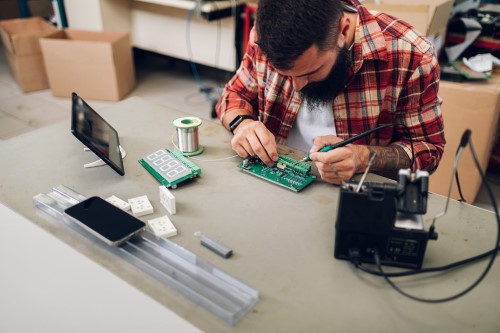
Hardware & Firmware QA and Testing Services for Embedded Devices
Embedded testing is a core service delivered by leading Hardware Quality Assurance(QA) companies and Firmware QA companies. Our Hardware Testing Services and Firmware QA services validate the quality, functionality, and integration of hardware, software, and firmware in your final product. We detect issues early and provide efficient Hardware bug fixing and Firmware bug fixing services, ensuring the entire embedded system works reliably under all required conditions.
ContactEmbedded Hardware & Firmware QA Services: Testing, Validation, and Business Value
Embedded QA and testing is a comprehensive process that verifies the reliability, stability, and performance of both hardware and firmware in an embedded system. Our Hardware Testing Services, Hardware QA services, Firmware QA services, and firmware testing services validate every critical layer of the device — from board electronics, sensors, and communication interfaces to drivers, RTOS components, and application-level firmware. Embedded testing focuses on how hardware and firmware interact in real time, ensuring consistent performance under various loads, temperature ranges, and environmental conditions. This includes embedded system validation, device compliance testing, hardware-in-the-loop (HIL) testing, and embedded product quality assurance.
Embedded devices operate in environments where failures are unacceptable. Even a small firmware defect or hardware instability can lead to downtime, field recalls, safety incidents, or certification delays. As one of the trusted Hardware QA companies, Firmware QA companies, and Hardware Testing companies, we identify integration issues early through functional, regression, stress, and interoperability testing. Our engineers provide rapid Hardware bug fixing services and Firmware bug fixing services, reducing development risks and improving long-term system reliability. We test IoT devices, industrial controllers, medical hardware, consumer electronics, power systems, wearables, and automotive modules — ensuring they meet industry standards, connectivity requirements, and regulatory expectations.
High-quality embedded QA increases product reliability, minimizes field failures, reduces maintenance costs, and accelerates time-to-market. With end-to-end hardware QA services and firmware testing services, we ensure your embedded device remains stable from prototype to mass production. Our expertise in embedded device testing, IoT quality assurance, firmware reliability testing, and embedded validation helps companies deliver market-ready products aligned with certifications such as ISO 13485, IEC standards, and industry-specific requirements. By partnering with us — a proven leader among hardware QA companies and firmware testing companies — you gain confidence that your embedded system is fully tested, validated, and ready for deployment at scale.
Key capabilities
.jpg)
Electronics Testing, Validation & Hardware QA Services
- Schematic and PCB review to confirm compliance with technical and hardware QA requirements - Signal conduction and power integrity analysis for stable electronic performance - PCB routing validation to detect high-speed and noise-sensitive layout issues - Signal verification on all inputs and outputs for reliable hardware–firmware interaction - Power management and distribution testing to ensure proper load behavior - Thermal camera temperature testing to validate performance across operating ranges

Embedded Firmware & Software QA and Testing Services
- Code review for each module according to firmware QA standards and best practices - Unit test development for all critical code modules to ensure functional reliability - Functional test creation to validate real device behavior under expected conditions - Hardware–firmware bring-up testing to verify correct initialization and interaction - Test utility development for automated log collection and analysis during firmware testing - Manual testing execution based on predefined test cases and embedded QA scenario
.jpg)
Mechanical Parts Testing, Validation & Enclosure QA Services
-Inspection of 3D-printed and injection-molded parts with comparison to original mechanical design -Material quality verification and usability assessment for durability and safety -Thermal camera temperature testing to validate material stability across operating ranges -Vibration testing to assess structural integrity under mechanical stress -IP rating verification and testing according to required protection standards

Mobile Application Testing, QA & Performance Validation Services
- Code review for each module according to mobile QA and coding standards - Unit, manual, and functional testing to validate core app behavior - UI/UX comparative testing against the original design specifications - Compatibility testing across screen sizes, resolutions, and platform versions - Performance and load testing for BLE, Wi-Fi, and NFC communication channels - Stress, compatibility, and localization testing for real-world usage scenarios
Tools that we use
Project process
PCB Signal Verification and Hardware QA Testing
During the hardware verification stage, our engineers perform detailed signal checks as part of our Hardware Testing Services and Hardware QA Services. The assembled PCB is connected to a laboratory power supply with a controlled current limit, and the required input voltage is applied. Using professional measurement equipment, the engineer verifies voltages and currents across all critical PCB nodes to ensure the board operates within expected parameters. Based on the collected data, we prepare an errata report and apply necessary corrections on the current PCB — including component adjustments, solder fixes, or temporary wiring. This process supports early hardware bug fixing services and helps avoid costly redesigns, ensuring the quality expected from leading hardware testing companies and hardware QA companies.

Circuit Protection Testing as Part of Hardware QA & Testing Services
During circuit protection testing, our engineer evaluates every input and output pin of the PCB according to the required protection specifications as part of our Hardware Testing Services and Hardware QA Services. This includes verifying maximum input voltage limits, conducting ESD testing using high-voltage generators and certified laboratory equipment, and performing polarity reversal tests by switching the input power polarity. Once all test results are analyzed, the engineer updates the errata document and identifies necessary corrections—such as adjusting components or applying temporary fixes. This workflow supports early hardware bug fixing services and ensures the quality and reliability expected from leading hardware testing companies and hardware QA companies.

Power Consumption Testing for Low-Power Embedded Hardware
For battery-powered and low-power embedded devices, power consumption testing is one of the most time-consuming stages of our Hardware Testing Services and Hardware QA Services. The engineer performs detailed current measurements across all operating modes — active mode, idle, sleep, and deep-sleep — verifying consumption on every critical component. All measured values are compiled into a results table and compared with theoretical calculations based on component datasheets. If discrepancies are detected, the engineer identifies the source of excess power draw and applies necessary corrections, which may include component re-soldering, replacing parts, or adjusting circuitry. This precise diagnostic flow supports early hardware bug fixing services and ensures the level of reliability expected from leading hardware testing companies and hardware QA companies.

Antenna Matching Testing for RF Hardware Validation
For embedded devices that include RF circuitry, antenna matching testing is a critical part of our Hardware Testing Services and Hardware QA Services. During this process, the engineer connects a vector network analyzer directly to the RF input/output section—bypassing the transmitter IC—to measure impedance characteristics at the device’s operating frequency. To ensure efficient RF performance, the impedance must be as close as possible to 50 ohms at the target frequency. If the antenna or matching network deviates from this value, the engineer selects and adjusts appropriate components within the RF circuit to achieve proper matching. (Pre-layout simulation of the RF output stage is essential to ensure successful PCB-level tuning.) These steps allow early detection of RF performance issues, support accurate tuning, and help maintain the quality expected from leading hardware testing companies and hardware QA companies, while also reducing redesign needs through precise hardware bug fixing services.

Functional Hardware Testing Using Test Firmware
Functional testing with test firmware is a critical stage of our Hardware Testing Services and Hardware QA Services. After verifying that the device has no power stability or connection issues, the engineer loads dedicated test firmware to validate all hardware-dependent components. This includes checking temperature sensors, memory modules, communication interfaces, and other peripherals, ensuring that each element operates correctly under controlled conditions. All results are recorded in a detailed test log, supporting accurate diagnostics and early hardware bug fixing services. This workflow reflects the quality standards expected from leading hardware testing companies and hardware QA companies, ensuring reliable hardware–firmware interaction before moving to the next development stage.

Heating & Temperature Range Testing for Embedded Hardware
Heating and temperature range testing is performed once the device is fully functional and test firmware is successfully loaded. As part of our Hardware Testing Services and Hardware QA Services, the engineer places the device into a thermal chamber and gradually shifts the temperature from the minimum to the maximum operating range, using slow transitions and small increments to avoid thermal shock. Throughout the process, the device’s stability, sensor behavior, power consumption, and interface performance are monitored across all temperature points. The engineer then prepares a detailed test report summarizing the results, highlighting any deviations, and providing recommendations for further improvements. This step ensures reliable operation under real environmental conditions and supports early diagnostics and hardware bug fixing services, meeting the quality expectations of leading hardware testing companies and hardware QA companies.

EMI/EMC Pre-Compliance Evaluation for Embedded Hardware
EMI/EMC evaluation is one of the final and most important stages of our Hardware Testing Services and Hardware QA Services before submitting a device for certification. In our laboratory, we perform pre-compliance EMI/EMC testing using a spectrum analyzer (up to 26 GHz) equipped with a range of antennas to measure emissions across different frequency bands. The engineer checks the radiated and conducted spectrum of the device in all operating modes and ensures that emission levels remain within the acceptable limits defined by regulatory requirements. This early assessment helps identify potential issues before moving to certified test facilities, significantly reducing project risk and cost. After passing internal pre-testing, we proceed to full EMI/EMC certification in an accredited external laboratory. Additional details and real test footage are available on the pre-certification service page: https://droid-technologies.com/services/precer as well as in this video demonstration: https://www.youtube.com/watch?v=zCEabo3tVxQ This structured approach reflects the quality expected from leading hardware testing companies and hardware QA companies, ensuring reliable electromagnetic performance and certification readiness.

Static Code Analysis for Firmware QA & Compliance
As part of our Firmware QA services and embedded firmware testing, we perform in-depth static code analysis using industry-standard tools. This step verifies code quality, compliance with required programming standards (MISRA, ANSI, etc.), and best practices for C/C++ development. Static analysis allows us to detect potential defects early, reduce debugging time, and improve the maintainability and reliability of the firmware. By identifying issues before runtime, we streamline firmware bug fixing services and deliver the level of code quality expected from leading firmware QA companies and firmware testing services providers.

Firmware Code Review as Part of Firmware QA & Testing Services
Code review performed by an independent engineer is a key component of our Firmware QA services and ensures high firmware quality and maintainability. We divide the project into small, manageable tasks — each developed in a separate Git branch. When a task is completed, a merge request is created for the development branch, and a structured code review is performed using GitHub/GitLab workflows. Our engineers follow a Google-based coding style adapted for Embedded C/C++, checking logic, structure, readability, and potential defects. This process improves reliability, reduces future debugging effort, and strengthens overall firmware quality, supporting our firmware bug fixing services and aligning with the standards expected from leading firmware QA companies and firmware testing services providers.

Unit and Functional Test Coverage for Firmware QA
Ensuring unit and functional test coverage for every firmware module is a core part of our Firmware QA services and firmware testing services. Each function, method, and module is validated through dedicated unit tests or functional tests to confirm correct behavior and prevent regressions. For every module, our engineers create detailed test cases, instructions, and execution steps, followed by automated or manual test runs with report generation. This structured validation approach improves firmware reliability, simplifies firmware bug fixing, and ensures high-quality embedded software aligned with the standards of leading firmware QA companies.

Firmware Performance, Speed & Load Testing With Optimization
Speed and load testing is an essential part of our Firmware QA services, ensuring that the firmware operates efficiently under real-world conditions. Because embedded systems must be both fast and low-power, we measure the performance of complex code constructions, analyze execution time, and identify bottlenecks. Where possible, our engineers perform firmware optimization—refactoring logic, improving memory usage, and enhancing execution speed. This process increases device responsiveness, reduces power consumption, and improves long-term stability, supporting our firmware bug fixing services and maintaining the standards expected from leading firmware QA companies and firmware testing services.

Manual Firmware Testing and Module-Level Validation
Manual testing of each code module is a critical step in our Firmware QA services and firmware testing services. After functional logic is implemented, we prepare detailed test instructions for every module, describing step-by-step actions, expected outcomes, and validation criteria. These manual test procedures help verify correct module behavior, uncover edge-case issues, and confirm that the firmware meets its functional requirements. Based on the results, our team generates a structured report outlining defects, insights, and recommendations for firmware bug fixing and overall improvement, ensuring the quality expected from leading firmware QA companies.

Firmware Regression Testing and Final Validation
Regression testing is the final step of our Firmware QA services and ensures that all previously tested modules work correctly after new updates or fixes. Once every code module is covered by unit, functional, and manual tests, we execute a full regression test cycle that includes all operating scenarios and edge cases of the project. This comprehensive validation helps identify unexpected interactions between modules and prevents new defects from appearing during integration. Based on the regression results, we generate a detailed test report, apply necessary firmware bug fixing, and prepare the firmware for release — ensuring the level of quality expected from leading firmware QA companies and firmware testing services providers.

Static Code Analysis for IoT & BLE Mobile App QA
As part of our IoT mobile app testing services and mobile app QA for IoT devices, we perform static code analysis to ensure code quality, security, and compliance with coding standards. Using professional analyzers, we detect potential issues in app modules that interact with BLE, cloud APIs, and device-control logic. This early analysis reduces debugging time, improves maintainability, and enhances overall app reliability—especially for cloud-connected apps and mobile applications used to control hardware devices. The process strengthens our IoT app QA and validation services and enables smoother mobile app integration testing across BLE, Cloud, and API layers.

Code Review for IoT & BLE Mobile App Quality Assurance
Code review by a second engineer is a crucial component of our mobile app QA for IoT devices and ensures high-quality, maintainable code across all application modules. We divide the project into small, isolated tasks—each developed in its own Git branch. When a task is completed, a merge request is submitted to the development branch, where a structured review is performed using GitHub/GitLab workflows. This process allows us to validate logic related to BLE communication, cloud connectivity, and device-control functionality, ensuring the app remains stable and secure. Thorough code review supports our broader IoT mobile app testing services, strengthens mobile app integration testing, and improves long-term performance and reliability for cloud-connected and hardware-interacting apps.

Unit & Functional Test Coverage for IoT and BLE Mobile Applications
As part of our IoT mobile app testing services, every function, method, and module in the application undergoes structured unit or functional testing. This approach ensures that all critical components—especially those responsible for BLE communication, cloud synchronization, and device-control logic—are validated individually before full integration. For each module, we prepare detailed test cases, execution steps, and expected results, followed by test execution and report generation. This rigorous validation strengthens our mobile app QA for IoT devices, supports reliable mobile app integration testing across BLE/Cloud/API layers, and improves long-term app stability and performance.

UI/UX Comparative Testing for IoT & Device-Control Mobile Apps
As part of our mobile app QA for IoT devices, we perform UI/UX comparative testing to ensure the application delivers a smooth and intuitive experience across different screen sizes, devices, and platforms. First, our internal team—together with an experienced UX/UI designer—evaluates navigation flows, BLE interaction screens, cloud-connected interfaces, and device-control elements to verify usability and consistency. In the second stage, we involve real users to test the application, provide feedback, and identify areas that may affect usability, pairing processes, or interaction with hardware devices. This comprehensive approach strengthens our IoT app QA and validation services and ensures that both BLE and cloud-driven user flows feel seamless and reliable.

Performance, Speed & Load Testing for IoT and BLE Mobile Applications
Achieving optimal performance for IoT and device-control mobile applications is one of the most critical parts of our IoT mobile app testing services. We measure execution speed, responsiveness, and load behavior across all modules—especially those handling BLE communication, cloud data processing, and real-time device interactions. Our team analyzes complex code structures, identifies bottlenecks, and performs targeted optimization to improve speed, reduce latency, and enhance user experience. This step is essential for reliable mobile app performance testing for IoT, ensuring smooth operation during mobile app integration testing across BLE, Cloud, and API layers.

Stress Testing for IoT, BLE & Cloud-Connected Mobile Applications
Stress testing is an essential component of our IoT mobile app testing services, ensuring the application remains stable under high load and intensive real-world usage. Our team simulates heavy user activity—both through manual interaction and automated tests—to replicate scenarios such as rapid navigation, frequent BLE interactions, continuous device control, and large-scale data exchange with cloud services. Throughout this process, we analyze how the application utilizes system resources including memory, CPU, network throughput, and background processes. This helps us identify performance bottlenecks, improve reliability, and validate app behavior under extreme conditions, strengthening our mobile app performance testing for IoT and mobile app integration testing across BLE, Cloud, and API layers.

Localization Testing for IoT, BLE & Cloud-Connected Mobile Apps
Localization testing is an important part of our mobile app QA for IoT devices, ensuring that applications controlling hardware through BLE or cloud services function correctly across different regions and user environments. We create multiple emulators with various regional configurations—including interface languages, localization settings, and OS versions—to validate the app’s behavior in diverse environments. In addition to emulator-based validation, we conduct real-world testing with users from different countries to ensure accuracy, readability, correct data formatting, and a consistent user experience across markets. This process enhances global reliability for cloud-connected apps, strengthens our IoT app QA and validation services, and ensures seamless operation during mobile app integration testing across BLE, Cloud, and API layers.

Manual Module-Level Testing for IoT & BLE Mobile Applications
As part of our mobile app QA for IoT devices, we conduct detailed manual testing for each code module once the functional logic is implemented. This ensures that components responsible for BLE connectivity, cloud interactions, device control, and UI behavior operate correctly before full integration. For every module, we prepare comprehensive test instructions with step-by-step procedures and expected outcomes. Each scenario is executed manually, and the results are documented in a structured report. These reports help identify defects, validate user flows, and support targeted improvements, strengthening our IoT mobile app testing services, enhancing mobile app integration testing across BLE/Cloud/API layers, and ensuring long-term application stability.

Full Regression Testing for IoT, BLE & Cloud-Connected Mobile Apps
After all individual code modules are validated through unit, functional, and manual testing, we perform full regression testing as part of our IoT mobile app testing services. This ensures that new updates, bug fixes, or feature changes have not introduced unexpected issues—especially in modules handling BLE communication, cloud connectivity, device control, and real-time data synchronization. We execute all relevant use cases across the entire application, covering workflows typical for cloud-connected apps and mobile apps controlling hardware devices. Based on the regression results, we generate a comprehensive test report and implement all required fixes and improvements before the release. This process strengthens overall reliability, reinforces our mobile app QA for IoT devices, and ensures smooth operation during mobile app integration testing across BLE, Cloud, and API layers.

Mechanical Simulation for Enclosure Validation & Design Verification
Mechanical simulation is a core step in our mechanical design verification services and enclosure validation workflow. Using advanced CAD tools, the engineer performs simulations to evaluate temperature behavior under heating and cooling, analyze component strength with different materials, visualize the movement of mechanical parts inside the enclosure, and run injection molding simulation to verify manufacturability and plastic flow. These simulations significantly reduce development risks, improve enclosure reliability, and support accurate mechanical prototype testing before physical production.

Mechanical Design Review & Enclosure Validation by a Second Engineer
A second-engineer mechanical design review is an essential stage of our mechanical design verification services and enclosure validation workflow. During this step, a senior engineer examines all mechanical part files, checks compliance with technical requirements, evaluates adherence to design standards, and identifies potential issues affecting manufacturability or enclosure performance. Based on the review, a detailed report is prepared to support improvements, reduce development risks, and ensure the design is ready for mechanical prototype testing and further enclosure testing services.

Mechanical Prototype Evaluation & Enclosure Quality Verification
When the designed mechanical parts are manufactured—whether 3D-printed, machined, or injection-molded—we perform a detailed evaluation as part of our mechanical design verification services and enclosure validation process. The engineer inspects each prototype, checking dimensional accuracy, tolerances, material quality, and compliance with the technical documentation, design standards, and CAD specifications. Based on this review, we prepare a structured report outlining deviations, risks, and recommendations for improvement, ensuring the part is ready for reliable mechanical prototype testing and further enclosure testing services.

Assembly Process Evaluation for Enclosure & Mechanical Design Validation
During the assembly process evaluation, our engineer reviews how well the designed mechanical parts fit and function together as part of our mechanical design verification services and enclosure validation workflow. Using the assembly drawings, we assemble the device step-by-step and assess assembly speed, convenience, part alignment, and overall build quality. Based on the findings, we prepare a detailed improvement report, helping optimize manufacturability, reduce assembly risks, and ensure the product is ready for reliable mechanical prototype testing and further enclosure testing services.

User Experience, Ergonomics & Enclosure Usability Evaluation
To ensure a high-quality user experience and ergonomic enclosure design, fully assembled devices undergo a dedicated usability and ergonomics evaluation as part of our mechanical design verification services. Our engineering team, together with a UX specialist, tests how comfortable and intuitive the device is to hold, operate, and interact with. When required, external users are invited to perform hands-on tests and provide feedback. All insights are compiled into a structured report, helping refine ergonomics, improve enclosure usability, and enhance the overall product experience before moving to mechanical prototype testing or mass production.

Functional Device Testing for Enclosure & Mechanical Validation
The functional test is a key step in our mechanical design verification services and enclosure validation workflow. During this stage, the fully assembled device — including the PCB, enclosure, and all mechanical components — is tested according to a structured checklist of test cases. This ensures that mechanical parts operate correctly together, external components fit and function as intended, and the device performs reliably under real usage conditions. A detailed report is then generated, highlighting issues, risks, and recommended improvements before moving to mechanical prototype testing or mass-production refinement.

Thermal Chamber Temperature Range Testing for Enclosure & Mechanical Validation
During temperature range testing, the fully assembled device is placed inside a thermal chamber to evaluate its behavior under extreme environmental conditions as part of our mechanical design verification services and enclosure testing workflow. The engineer gradually shifts the chamber temperature from the minimum to the maximum operating limits, using slow transitions and small increments to accurately assess material stability, enclosure performance, and internal component behavior. All findings are documented in a detailed report, outlining deviations, risks, and recommendations for improvement before the device proceeds to mechanical prototype testing or certification-level environmental tests.

Vibration Testing for Enclosure Durability & Mechanical Design Verification
During vibration testing, the fully assembled device is mounted on a vibration stand to evaluate structural integrity and enclosure durability as part of our mechanical design verification services and enclosure testing workflow. The vibration level is gradually increased from the minimum to the maximum operating range, using slow transitions and controlled increments to identify mechanical weaknesses, loose components, or assembly-related issues. After completing the test cycle, the engineer prepares a detailed report summarizing the results and recommending improvements before the device proceeds to mechanical prototype testing or further environmental validation.

IP Protection (Ingress Protection) Testing for Enclosure Validation
Ingress Protection (IP) testing is one of the final and most critical stages of our enclosure testing services and mechanical design verification workflow. The assembled device is tested in specialized chambers that allow precise control of humidity, water pressure, air pressure, and dust concentration, according to the required IP rating (IP54, IP67, IP68, etc.). IP testing is performed based on the device’s specifications and intended environmental conditions. After completing all test cycles, the engineer prepares a detailed report documenting compliance, deviations, and recommendations for improvement before moving to mechanical prototype testing or certification.

Our Offices

Kyiv
Ukraine, Kyiv City, str Vaclav Havel 4, office 422

Vinnytsia
Ukraine, Vinnytsia City, Kyivska 41

Kharkiv
Ukraine, Kharkiv City, St. Karazyna 1,
Kyiv
Vinnytsia
Kharkiv

Kyiv

Vinnytsia

Kharkiv

What can we do for you?
Feel free to get in touch

+380442374050
Ready to request a quote?

Describe your project
Ask for advice from our experts right now
Want to learn more? Need some help with product development? Tell us about your business needs. We will find the perfect solution















